Effect of Potato Glycoside Alkaloids on Energy Metabolism of Fusarium solani
Abstract
1. Introduction
2. Materials and Methods
2.1. Materials
2.2. Preparation of F. solani Spore Suspensions
2.3. Antifungal Effect of PGA
2.4. Determination of Biomass of F. solani
2.5. Determination of Spore Germination Rate of F. solani
2.6. Determination of Glucose and Pyruvate Contents, Hexokinase (HK), Pyruvate Kinase (PK), and Fructose-6-Phosphate Kinase (PFK) Activities of F. solani
2.7. Determination of ATPase Activity of F. solani
2.8. Determination of the Mitochondrial Complex Activity of F. solani
2.9. Determination of Mitochondrial Permeability Transition Pore (MPTP) and Matrix Ca2+ Content of F. solani
2.10. Determination of the Content of 5′-Triphosphate (ATP), 5′-Diphosphate (ADP), 5′-Monophosphate (AMP), and EC of F. solani Mycelia
2.11. Statistical Analysis
3. Results
3.1. Antimicrobial Effects of PGA
3.2. Effect of PGA on Spore Germination of F. solani
3.3. Effects of PGA Treatment on the Glucose and Pyruvate Contents of F. solani
3.4. Effects of PGA Treatment on the HK, PK, and PFK Activities of F. solani
3.5. Effect of PGA on the ATPase Activity of F. solani
3.6. Effect of PGA Treatment on the Complex Activity of F. solani
3.7. Effects of PGA on Ca2+ Content and Permeability Transition Pore (MPTP) in the Mitochondrial Matrix of F. solani
3.8. Effects of PGA on ATP, ADP, and AMP Content in F. solani
4. Discussion
5. Conclusions
Author Contributions
Funding
Institutional Review Board Statement
Informed Consent Statement
Data Availability Statement
Acknowledgments
Conflicts of Interest
References
- Parikh, L.; Kodati, S.; Eskelson, M.J.; Adesemoye, A.O. Identification and pathogenicity of Fusarium spp. in row crops in Nebraska. Crop Prot. 2018, 108, 120–127. [Google Scholar] [CrossRef]
- Morales-Rodríguez, I.; Yanez-Morales, M.J.; Silva-Rojas, H.V.; García-de-los-Santos, G.; Guzman-de-Pena, D.A. Biodiversity of Fusarium species in mexico associated with ear rot in maize, and their identification using a phylogenetic approach. Mycopathologia 2007, 163, 31–39. [Google Scholar] [CrossRef]
- Elgayyar, M.; Draughon, F.A.; Golden, D.A.; Mount, J.R. Antimicrobial activity of essential oils from plants against selected pathogenic and saprophytic microorganisms. J. Food Prot. 2001, 64, 1019–1024. [Google Scholar] [CrossRef]
- Xu, M.H.; Liu, K.W.; Zhang, X.H.; Yang, X.Y.; Fu, M.R. Research Progress on Solanine in Potato Tubers. Storage and Process. Storage Process 2017, 17, 112–116+121. [Google Scholar]
- Schieber, A.; Saldaña, M. Potato peels: A source of nutritionally and pharmacologically interesting compounds—A review. Food 2009, 3, 23–29. [Google Scholar] [CrossRef]
- Sanchez Maldonado, A.F.; Mudge, E.; Gӓnzle, M.G.; Schieber, A. Extraction and fractionation of phenolic acids and glycoalkaloids from potato peels using acidified water/ethanol-based solvents. Food Res. Int. 2014, 65, 27–34. [Google Scholar] [CrossRef]
- Stobiecki, M.; Matysiak-Kata, I.; Frański, R.; Skała, J.; Szopa, J. Monitoring changes in anthocyanin and steroid alkaloid glycoside content in lines of transgenic potato plants using liquid chromatography/mass spectrometry. Phytochemistry 2003, 62, 959–969. [Google Scholar] [CrossRef]
- Rocha, A.B.O.; Honório, S.L.; Messias, C.L.; Otón, M.; Gómez, P.A. Effect of UV-c radiation and fluorescent light to control postharvest soft rot in potato seed tubers. Sci. Hortic. 2015, 181, 174–181. [Google Scholar] [CrossRef]
- Joshi, J.; Yao, L.X.; Charkowski, A.O.; Heuberger, A.L. Metabolites from wild potato inhibit virulence factors of the soft rot and blackleg pathogen Pectobacterium brasiliense. Mol. Plant-Microbe Interact. 2021, 34, 100–109. [Google Scholar] [CrossRef]
- Sánchez-Maldonado, A.F.; Schieber, A.; Gänzle, M.G. Antifungal activity of secondary plant metabolites from potatoes (Solanum tuberosum L.): Glycoalkaloids and phenolic acids show synergistic effects. J. Appl. Microbiol. 2016, 120, 955–965. [Google Scholar] [CrossRef]
- Dahlin, P.; Müller, M.C.; Ekengren, S.; Mckee, L.S.; Bulone, V. The Impact of Steroidal Glycoalkaloids on the Physiology of Phytophthora infestans, the Causative Agent of Potato Late Blight. Mol. Mol. Plant-Microbe Interact. 2017, 30, 531–542. [Google Scholar] [CrossRef]
- Xu, N.; Lu, H.; Yi, X.Q.; Peng, S.M.; Huang, X.H.; Zhang, Y. Potential of Alpha-(α)-Solanine as a Natural Inhibitor of Fungus Causing Leaf Spot Disease in Strawberry. Life 2023, 13, 450. [Google Scholar] [CrossRef]
- Li, H.; Li, M.; Fang, Y.L.; Qin, S.H. Antifungal activity of potato glycoalkaloids and its potential to control severity of dry rot caused by Fusarium sulphureum. Crop Sci. 2023, 63, 801–811. [Google Scholar] [CrossRef]
- Zheng, S.; Jing, G.; Wang, X.; Ouyang, Q.; Jia, L.; Tao, N. Citral exerts its antifungal activity against Penicillium digitatum by affecting the mitochondrial morphology and function. Food Chem. 2015, 178, 76–81. [Google Scholar] [CrossRef]
- Nakayama, H.; Otsu, K. Mitochondrial DNA as an inflammatory mediator in cardiovascular diseases. Biochem. J. 2018, 475, 839–852. [Google Scholar] [CrossRef]
- Ma, W.B.; Zhao, L.L.; Zhao, W.H.; Xie, Y.L. (E)-2-Hexenal, as a Potential Natural Antifungal Compound, Inhibits Aspergillus flavus Spore Germination by Disrupting Mitochondrial Energy Metabolism. J. Agric. Food Chem. 2019, 67, 1138–1145. [Google Scholar] [CrossRef]
- He, J.; Duo, T.T.; Chen, W.; Zhang, X.Y. Mechanism of Action of Potato Glycoalkaloids against Fusarium solani. Int. J. Agric. Biol. 2021, 25, 873–880. [Google Scholar] [CrossRef]
- Ding, D.D.; Zhao, J.T.; He, J.; Hou, C.X.; Li, N.; Zhang, C.Q.; Zhao, Q. Potato glycoalkaloids affect the respiration and reactive oxygen species metabolism of Fusarium solani. Microbiology 2023, 50, 1–13. Available online: https://kns.cnki.net/kcms/detail//11.1996.Q.20230104.1430.003.html (accessed on 15 June 2023).
- Kasnak, C.; Artik, N. Change in Some Glycoalkaloids of Potato under Different Storage Regimes. Potato Res. 2018, 61, 183–193. [Google Scholar] [CrossRef]
- Lachhab, N.; Sanzani, S.M.; Bahouaoui, M.A.; Boselli, M.; Ippolito, A. Effect of some protein hydrolysates against gray mould of table and wine grapes. Eur. J. Plant Pathol. 2016, 144, 821–830. [Google Scholar] [CrossRef]
- Yan, H.J.; Yun, J.M.; Ai, D.Y.; Zhang, W.W.; Bai, J.; Guo, J. Two novel cationic antifungal peptides isolated from Bacillus pumilus HN-10 and their inhibitory activity against Trichothecium roseum. World J. Microbiol. Biotechnol. 2018, 34, 21–41. [Google Scholar] [CrossRef]
- Li, L.M.; Zheng, T.T.; Chen, Y.Q.; Sui, Y.; D, R.H.; Hou, L.W.; Zheng, F.L.; Zhu, C.Y. The antagonistic mechanisms of Streptomyces sioyaensis on the growth and metabolism of poplar canker pathogen Valsa sordida. Biol. Control 2020, 151, 104392. [Google Scholar] [CrossRef]
- Li, S.K.; Ji, Z.Q.; Zhang, J.W.; Guo, Z.Y.; Wu, W.J. Synthesis of 1-acyl-3-isopropenylbenzimidazolone derivatives and their activity against Botrytis cinerea. J. Agric. Food Chem. 2010, 58, 2668–2672. [Google Scholar] [CrossRef]
- Yang, L.; Liu, Y.H.; Ruan, R.S. Rapid Determination of 5-Hydroxymethylfurfural by Ultraviolet Spectrophotometry in Glucose Diphasic Hydrolysate. AMR 2012, 361–363, 1713–1717. [Google Scholar] [CrossRef]
- Chen, W.; Liang, J.; He, Z.; Jiang, W. Preliminary study on total protein extraction methods from Enterococcus faecalis biofilm. Genet Mol. Res. 2016, 15, 15038988. [Google Scholar] [CrossRef]
- Galina, V.; Vandanajay, B.; Arpad, G.; John, P.; Nisha, G. Impaired mitochondrial respiratory chain and bioenergetics during chagasic cardiomyopathy development. Biochim. Biophys. Acta 2004, 1689, 162–173. [Google Scholar] [CrossRef]
- Wu, S.J.; Yun, J.M.; Wang, R.; Zhang, W.W.; Hao, L.; Pei, P.Z. Analysis of the effects of antifungal peptide P-1 from Bacillus pumilus HN-10 on energy metabolism of Trichothecium roseum. Food Biosci. 2022, 47, 101668. [Google Scholar] [CrossRef]
- Gazdag, P.; Oravecz, K.; Acsai, K.; Demeter-Haludka, V.; Ördög, B.; Szlovák, J.; Kohajda, Z.; Polyák, A.; Barta, B.A.; Oláh, A.; et al. Author Correction: Increased Ca2+ content of the sarcoplasmic reticulum provides arrhythmogenic trigger source in swimming-induced rat athlete’s heart model. Sci. Rep. 2021, 11, 12249. [Google Scholar] [CrossRef]
- Peng, L.T.; Yang, S.Z.; Cheng, Y.J.; Chen, F.; Pan, S.Y.; Fan, G. Antifungal activity and action mode of pinocembrin from propolis against Penicillium italicum. Food Sci. Biotechnol. 2012, 21, 1533–1539. [Google Scholar] [CrossRef]
- Wulfert, S.; Schilasky, S.; Krueger, S. Transcriptional and Biochemical Characterization of Cytosolic Pyruvate Kinases in Arabidopsis thaliana. Plants 2020, 9, 353. [Google Scholar] [CrossRef]
- De, R.V.; Roitsch, T.; Franken, P. Extracellular Glycolytic Activities in Root Endophytic Serendipitaceae and Their Regulation by Plant Sugars. Microorganisms 2022, 10, 320. [Google Scholar] [CrossRef]
- Amendola, C.R.; Mahaffey, J.P.; Parker, S.J.; Ahearn, I.M.; Chen, W.C.; Zhou, M.; Court, H.; Shi, J.; Mendoza, S.L.; Morten, M.J.; et al. KRAS4A directly regulates hexokinase 1. Nature 2019, 576, 482–486. [Google Scholar] [CrossRef]
- Tong, G.; Yulong, M.; Peng, G.; Zirong, X. Antibacterial effects of the Cu (II)-exchanged montmorillonite on Escherichia coli K88 and Salmonella choleraesuis. Vet. Microbiol. 2005, 105, 113–122. [Google Scholar] [CrossRef] [PubMed]
- Meng, X.J.; Yu, J.D.; Zheng, X.M. Regulations of small-molecules metabolites on hexokinase and pyruvate kinase in Aspergillus niger. Biotechnol. Bull. 2021, 37, 180–190. [Google Scholar] [CrossRef]
- Han, P.P.; Wei, Y.Y.; Jiang, S.; Chen, Y.; Xu, F.; Wang, H.F.; Shao, X.F. N-Acetyl-d-glucosamine Inhibition of Hexokinase Results in Downregulation of the Phenylpropanoid Metabolic Pathway and Decreased Resistance to Brown Rot in Peach Fruit. J. Agric. Food Chem. 2022, 70, 3917–3928. [Google Scholar] [CrossRef]
- Zhang, S.; Wakai, S.; Sasakura, N.; Tsutsumi, H.; Hata, Y.; Ogino, C.; Kondo, A. Pyruvate metabolism redirection for biological production of commodity chemicals in aerobic fungus Aspergillus oryzae. Metab. Eng. 2020, 61, 225–237. [Google Scholar] [CrossRef]
- Li, Q.; Zhao, Y.; Zhu, X.; Xie, Y. Antifungal effect of o-vanillin on mitochondria of Aspergillus flavus: Ultrastructure and TCA cycle are destroyed. Int. J. Food Sci. Technol. 2022, 57, 3142–3149. [Google Scholar] [CrossRef]
- Pinto, E.; Hrimpeng, K.; Lopes, G.; Vaz, S.; Gonçalves, M.J.; Cavaleiro, C.; Salgueiro, L. Antifungal activity of Ferulago capillaris essential oil against Candida, Cryptococcus, Aspergillus and dermatophyte species. Eur. J. Clin. Microbiol. Infect. Dis. 2013, 32, 1311–1320. [Google Scholar] [CrossRef] [PubMed]
- Carreté, R.; Vidal, M.T.; Bordons, A.; Constantí, M. Inhibitory effect of sulfur dioxide and other stress compounds in wine on the ATPase activity of Oenococcus oeni. FEMS Microbiol. Lett. 2002, 211, 155–159. [Google Scholar] [CrossRef] [PubMed]
- Azevedo, I.G.; Oliveira, J.G.; Da, S.M.G.; Pereira, T.; Correa, S.F.; Vargas, H.; Facanha, A.R. P-type H+-ATPases activity, membrane integrity, and apoplastic pH during papaya fruit ripening. Postharvest Biol. Technol. 2007, 48, 242–247. [Google Scholar] [CrossRef]
- Jia, M.; Li, Z.; Han, S.; Wang, S.; Jiang, J. Effect of 1-aminocyclopropane-1-carboxylic acid accumulation on Verticillium dahliae infection of upland cotton. BMC Plant Biol. 2022, 22, 386–398. [Google Scholar] [CrossRef]
- Kane, P.M. Proton transport and pH control in fungi. Adv. Exp. Med. Biol. 2016, 892, 33–68. [Google Scholar] [CrossRef]
- Förster, C.; Santos, M.A.; Ruffert, S.; Kramer, R.; Revuelta, J.L. Physiological Consequence of Disruption of the VMA1Gene in the Riboflavin Overproducer Ashbya gossypii. J. Biol. Chem. 1999, 274, 9442–9448. [Google Scholar] [CrossRef]
- Zhao, Y.; Yan, D.; Liu, J.; Yang, S.Z.; Li, D.M.; Peng, L.T. Vacuolar ATPase subunit H regulates growth development and pathogenicity of Penicillium digitatum. Postharvest Biol. Technol. 2023, 199, 112295. [Google Scholar] [CrossRef]
- Gulcan, H.; Ozturk, I.C.; Arslan, S. Alterations in antioxidant enzyme activities in cerebrospinal fluid related with severity of hypoxic ischemic encephalopathy in newborns. Neonatology 2005, 88, 87–91. [Google Scholar] [CrossRef] [PubMed]
- Lin, L.; Gu, Y.L.; Li, C.Z.; Vittayapadung, S.; Cui, H.Y. Antibacterial mechanism of ε -Poly-lysine against Listeria monocytogenes and its application on cheese. Food Control 2018, 91, 67–78. [Google Scholar] [CrossRef]
- Li, S.F.; Zhang, K.; Chen, Y.Y.; Li, Z.B.; Hu, Q.B.; Weng, Q.F. Antifungal Activity of β-Carboline Alkaloids Compound and Its Resistance Mechanism on Peronophythora litchi. Int. J. Fruit Sci. 2022, 22, 646–663. [Google Scholar] [CrossRef]
- Mcbride, H.M.; Neuspiel, M.; Wasiak, S. Mitochondria: More than just a powerhouse. Curr. Biol. 2006, 16, R551–R560. [Google Scholar] [CrossRef] [PubMed]
- Shi, M.; Zhou, L.; Zhao, L.; Shang, M.; Huang, Y. Csseverin inhibits apoptosis through mitochondria-mediated pathways triggered by Ca2+ dyshomeostasis in hepatocarcinoma PLC cells. PLoS Negl. Trop. Dis. 2017, 11, e0006074. [Google Scholar] [CrossRef]
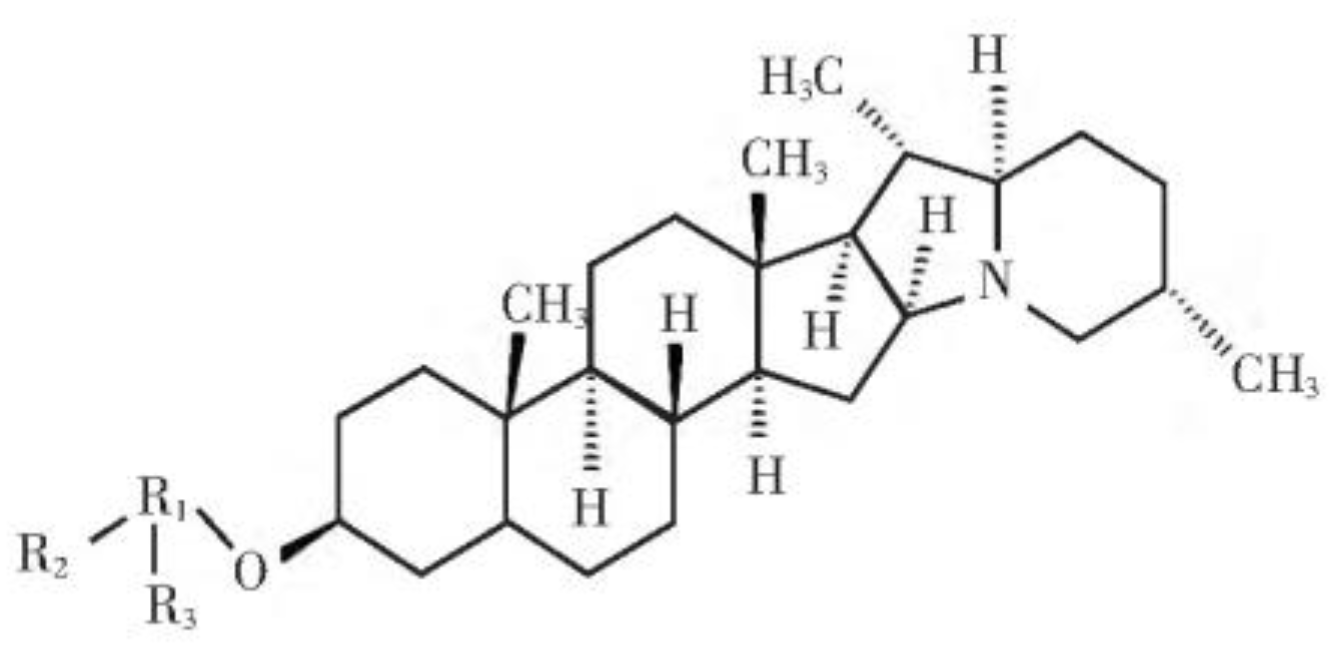
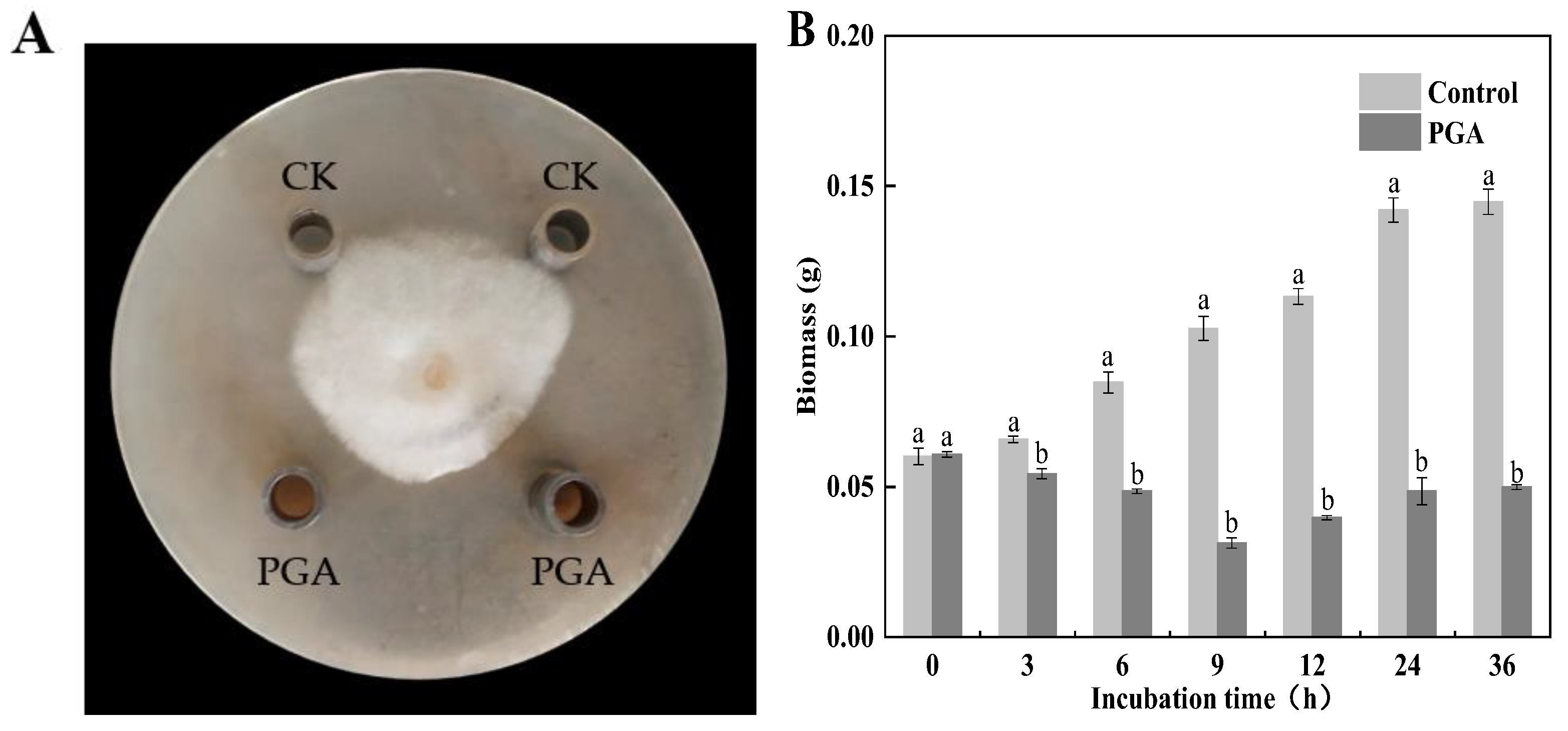
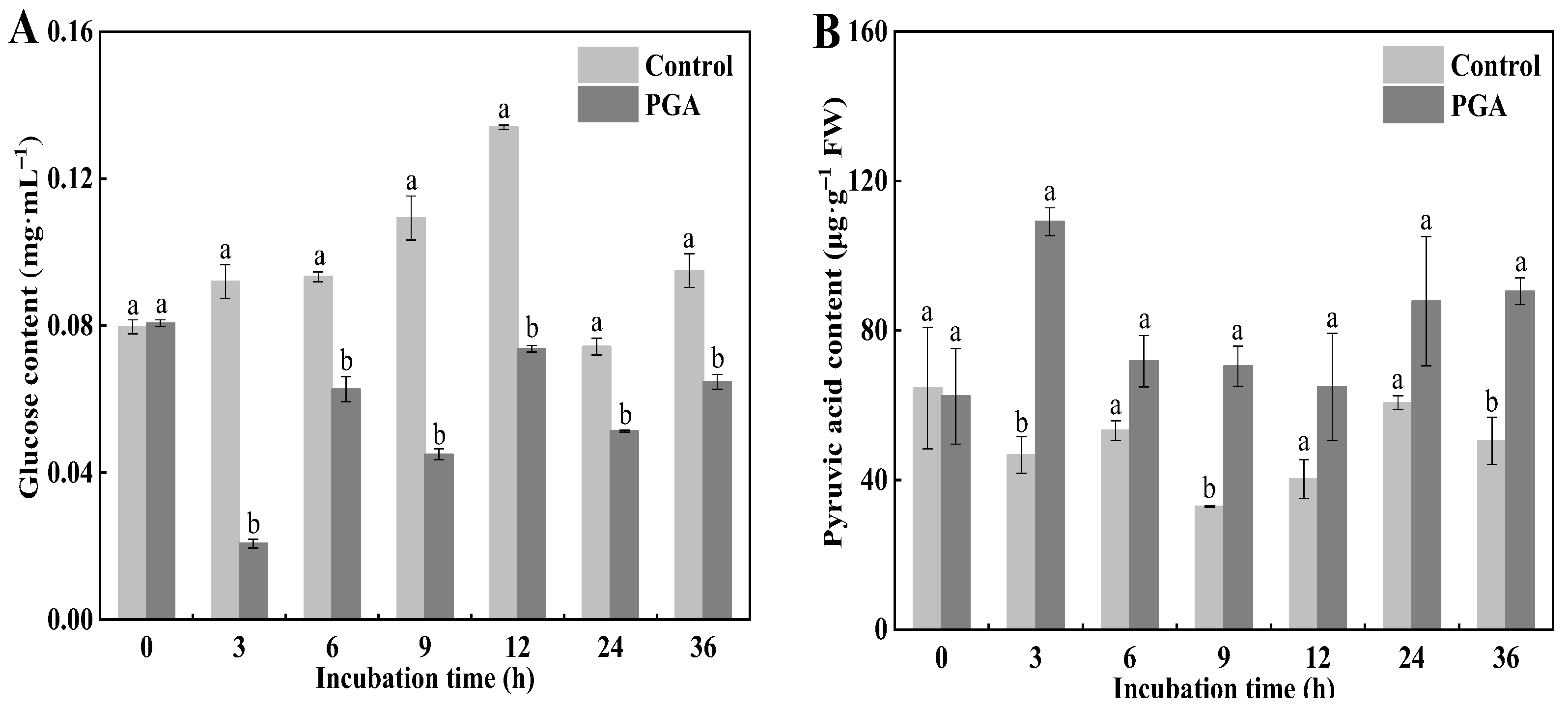

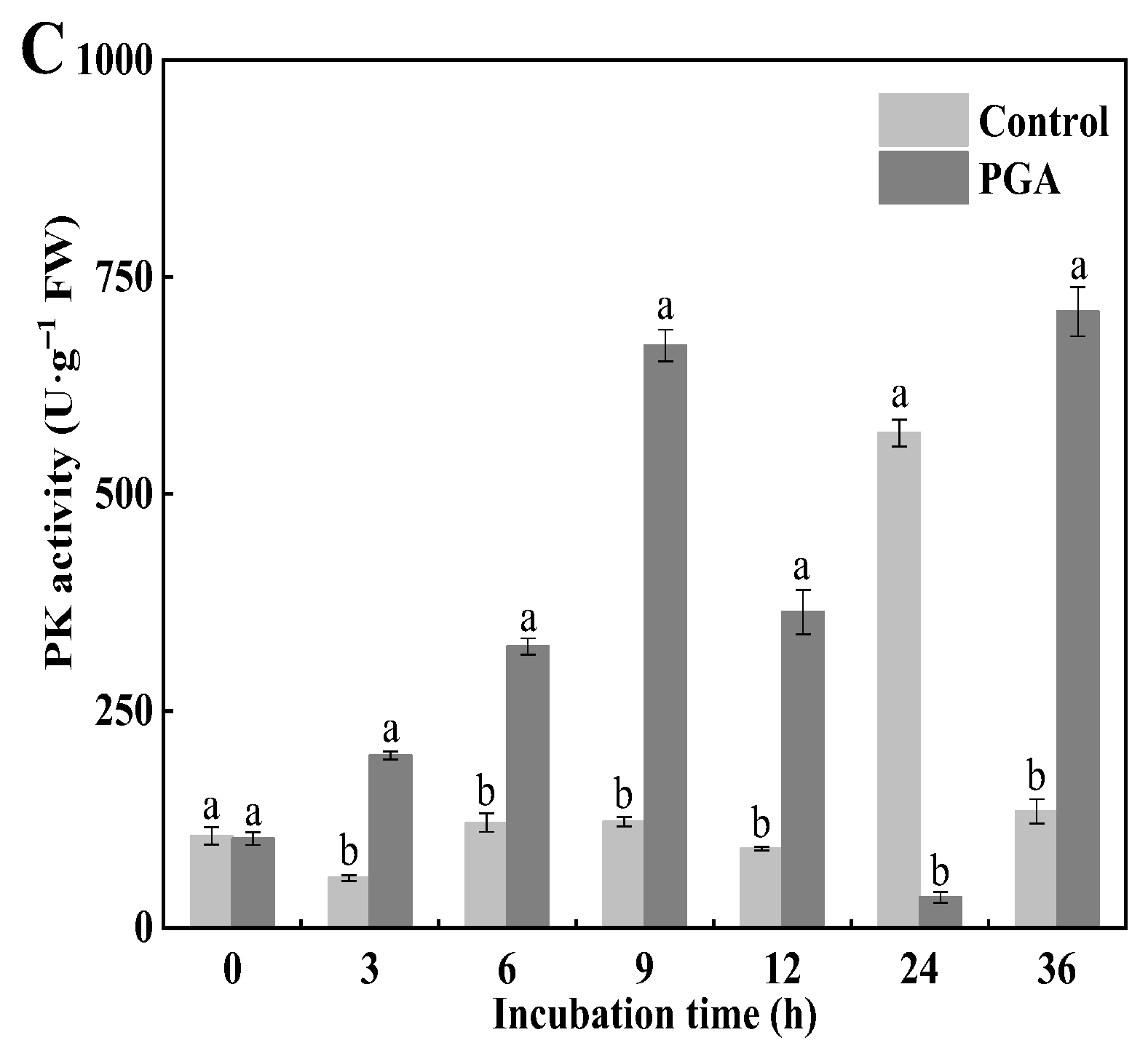
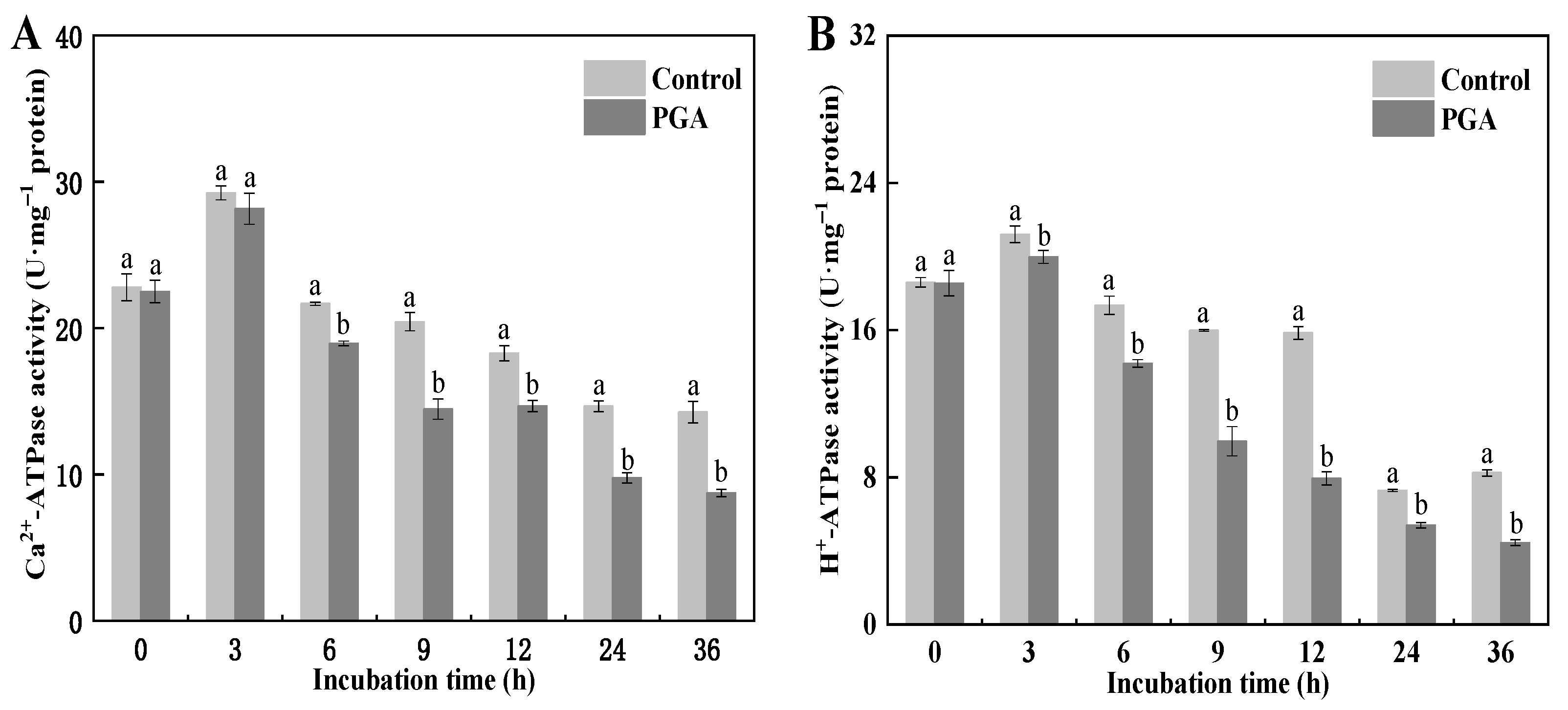
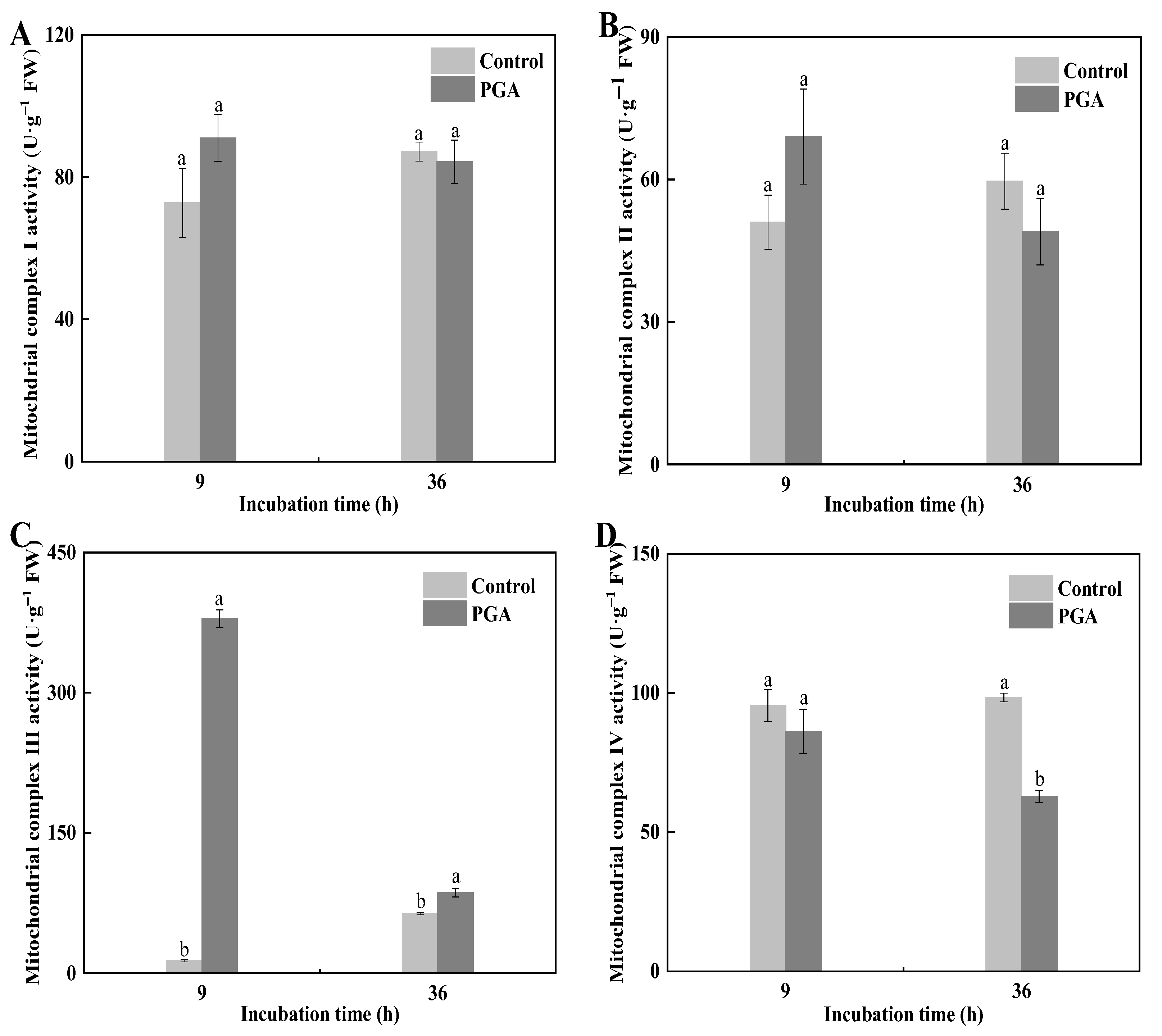
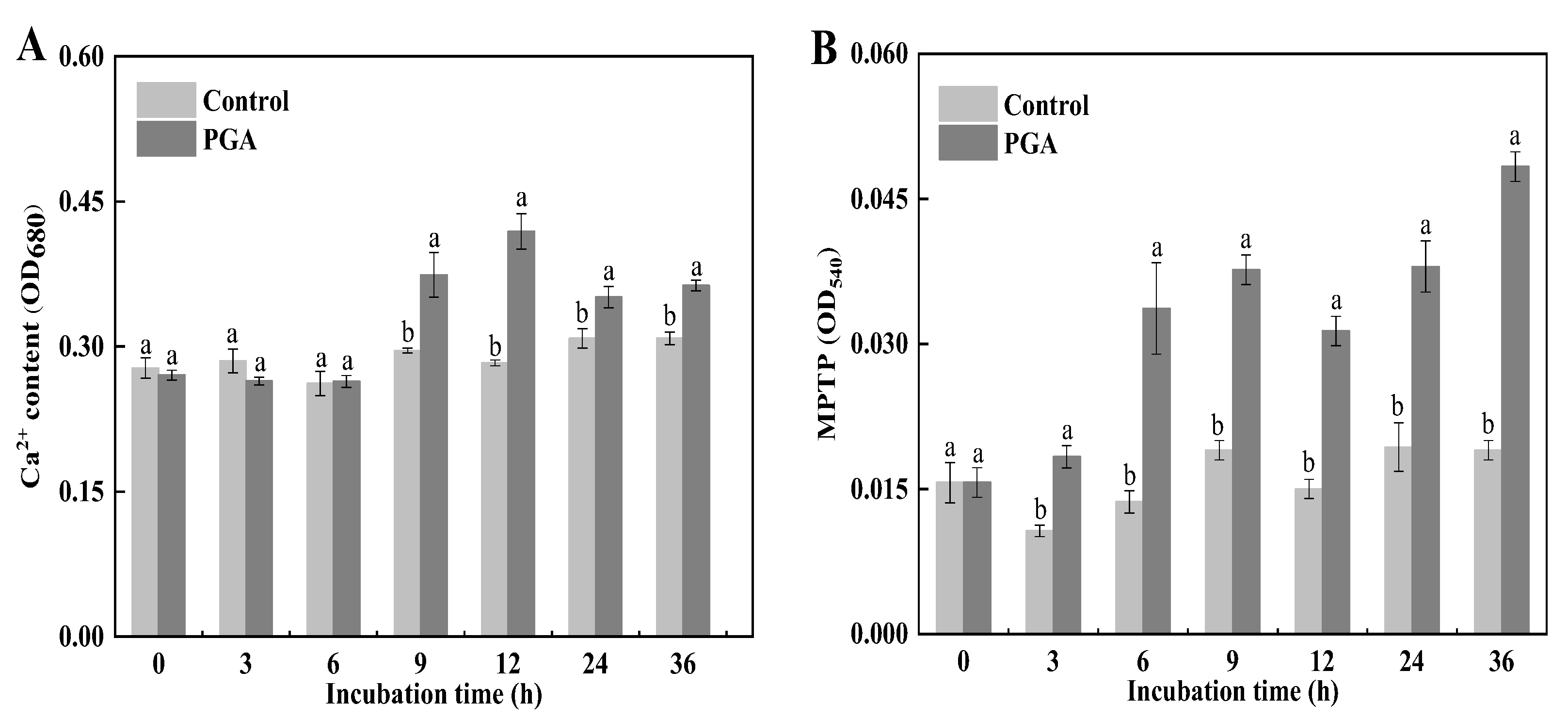
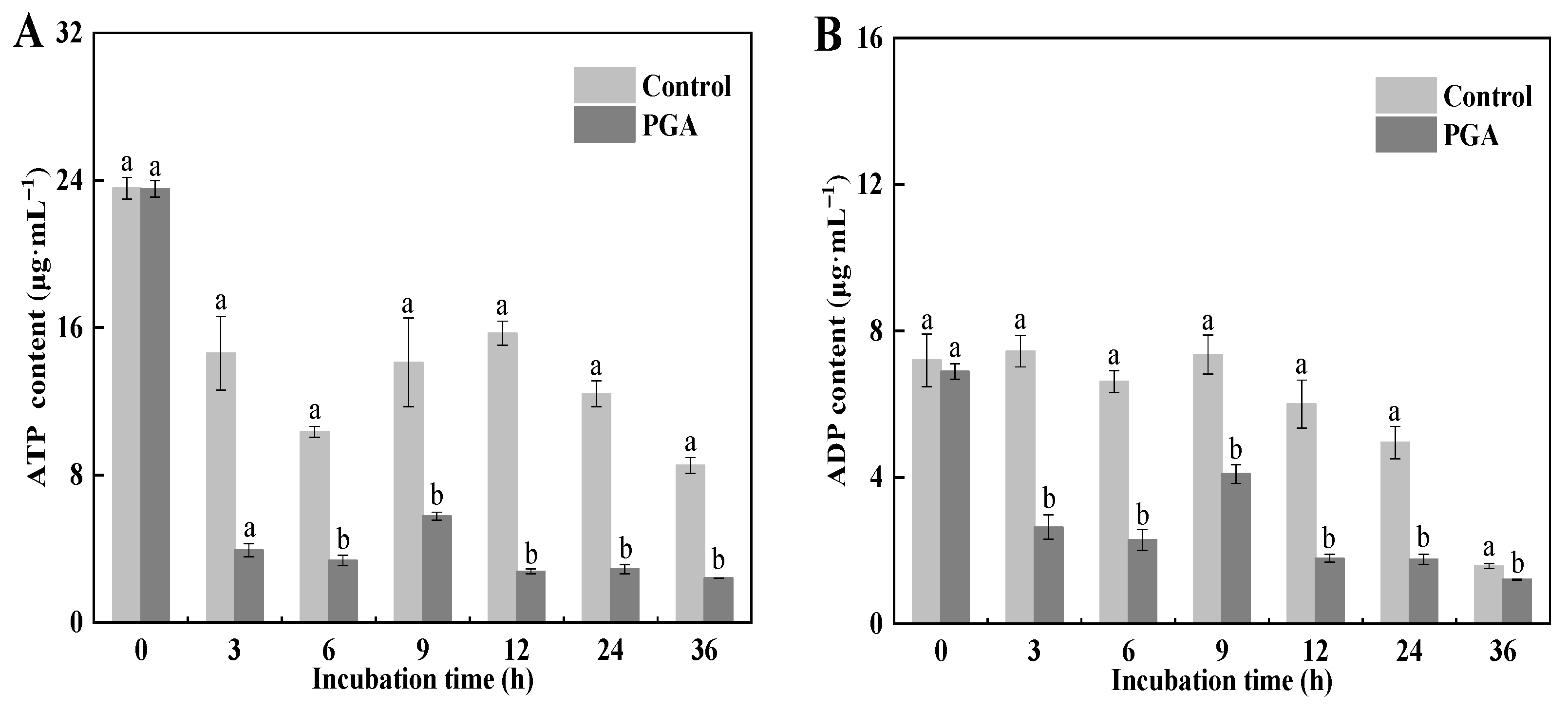
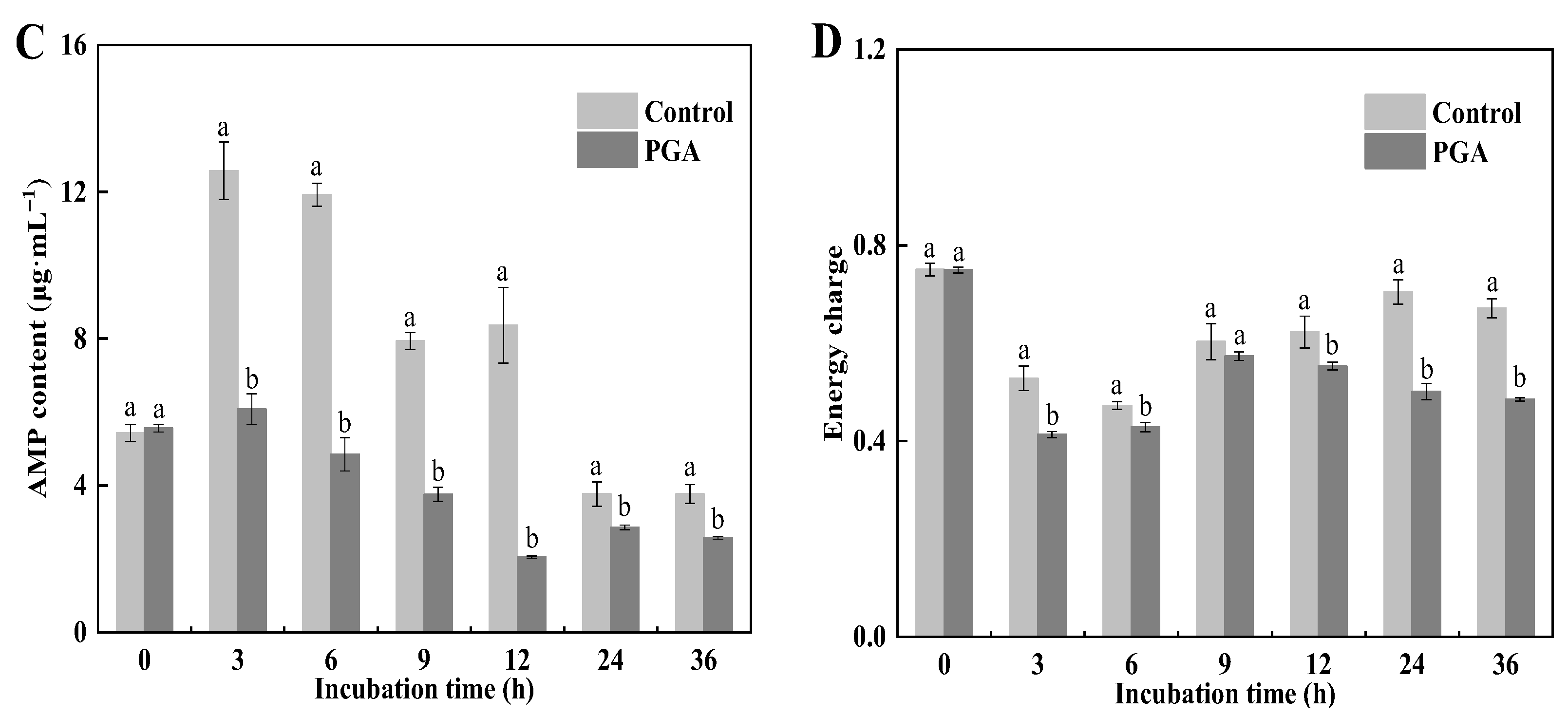
| Treatment | Rate of Spore Germination (%) | ||||
|---|---|---|---|---|---|
| 0 h | 3 h | 6 h | 9 h | 12 h | |
| Control | 2.84 ± 0.38 a | 3.80 ± 1.69 a | 70.96 ± 1.82 a | 94.79 ± 2.03 a | 97.95 ± 0.58 a |
| EC50 | 2.94 ± 0.34 a | 1.71 ± 0.42 b | 3.40 ± 0.42 d | 3.14 ± 0.46 e | 2.70 ± 0.57 e |
| 1/2 EC50 | 2.71 ± 0.59 a | 1.86 ± 0.74 b | 5.10 ± 0.15 d | 3.01 ± 1.17 e | 3.55 ± 1.01 e |
| 1/4 EC50 | 2.32 ± 0.89 a | 2.13 ± 0.40 ab | 5.02 ± 0.84 d | 22.62 ± 5.65 d | 44.04 ± 3.67 d |
| 1/8 EC50 | 2.68 ± 0.33 a | 2.27 ± 0.40 ab | 13.31 ± 1.82 c | 36.60 ± 2.28 c | 60.24 ± 0.82 c |
| 1/16 EC50 | 2.68 ± 0.39 a | 2.76 ± 0.48 a | 19.28 ± 2.56 b | 54.78 ± 4.88 b | 83.17 ± 1.71 b |
Disclaimer/Publisher’s Note: The statements, opinions and data contained in all publications are solely those of the individual author(s) and contributor(s) and not of MDPI and/or the editor(s). MDPI and/or the editor(s) disclaim responsibility for any injury to people or property resulting from any ideas, methods, instructions or products referred to in the content. |
© 2023 by the authors. Licensee MDPI, Basel, Switzerland. This article is an open access article distributed under the terms and conditions of the Creative Commons Attribution (CC BY) license (https://creativecommons.org/licenses/by/4.0/).
Share and Cite
Zhang, C.; Ding, D.; Wang, B.; Wang, Y.; Li, N.; Li, R.; Yan, Y.; He, J. Effect of Potato Glycoside Alkaloids on Energy Metabolism of Fusarium solani. J. Fungi 2023, 9, 777. https://doi.org/10.3390/jof9070777
Zhang C, Ding D, Wang B, Wang Y, Li N, Li R, Yan Y, He J. Effect of Potato Glycoside Alkaloids on Energy Metabolism of Fusarium solani. Journal of Fungi. 2023; 9(7):777. https://doi.org/10.3390/jof9070777
Chicago/Turabian StyleZhang, Chongqing, Dedong Ding, Bin Wang, Yupeng Wang, Nan Li, Ruiyun Li, Yuke Yan, and Jing He. 2023. "Effect of Potato Glycoside Alkaloids on Energy Metabolism of Fusarium solani" Journal of Fungi 9, no. 7: 777. https://doi.org/10.3390/jof9070777
APA StyleZhang, C., Ding, D., Wang, B., Wang, Y., Li, N., Li, R., Yan, Y., & He, J. (2023). Effect of Potato Glycoside Alkaloids on Energy Metabolism of Fusarium solani. Journal of Fungi, 9(7), 777. https://doi.org/10.3390/jof9070777






